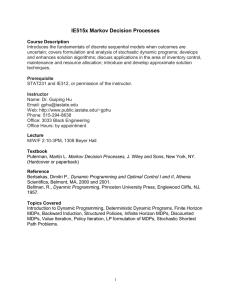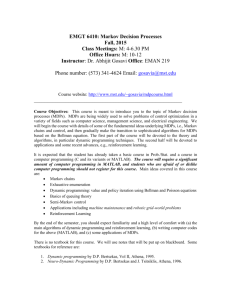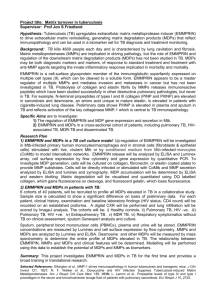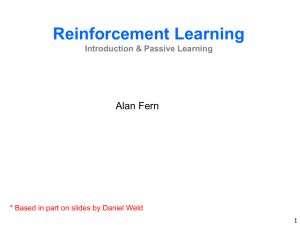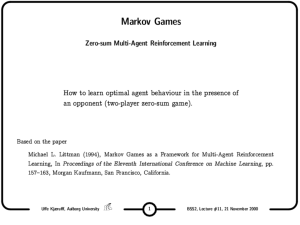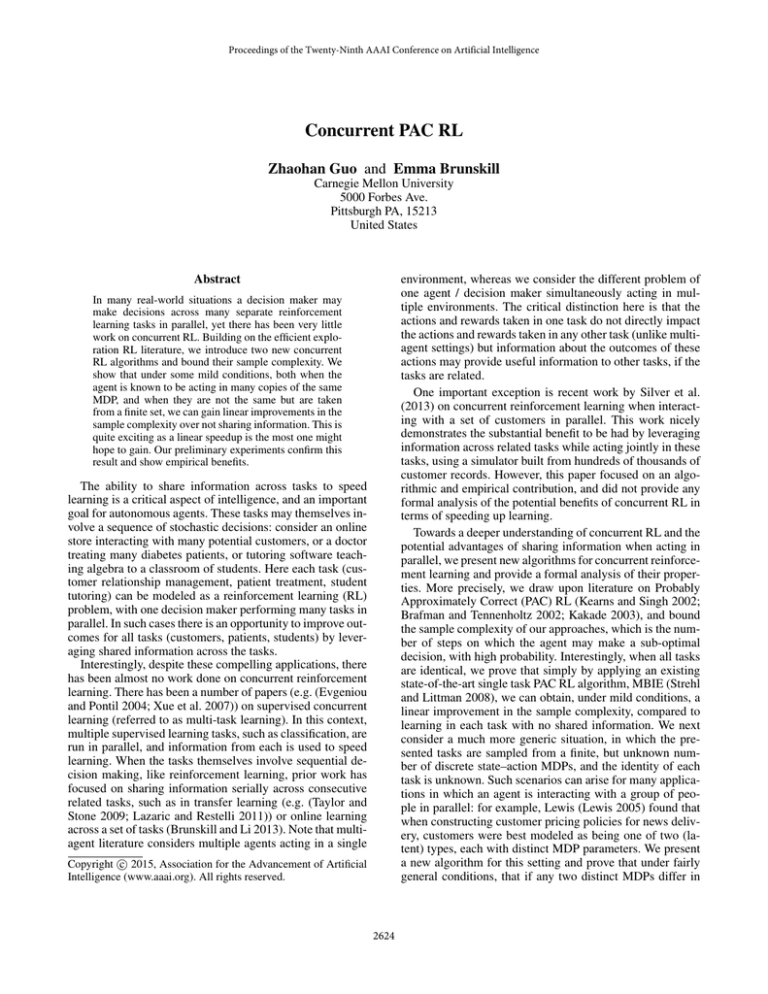
Proceedings of the Twenty-Ninth AAAI Conference on Artificial Intelligence
Concurrent PAC RL
Zhaohan Guo and Emma Brunskill
Carnegie Mellon University
5000 Forbes Ave.
Pittsburgh PA, 15213
United States
Abstract
environment, whereas we consider the different problem of
one agent / decision maker simultaneously acting in multiple environments. The critical distinction here is that the
actions and rewards taken in one task do not directly impact
the actions and rewards taken in any other task (unlike multiagent settings) but information about the outcomes of these
actions may provide useful information to other tasks, if the
tasks are related.
One important exception is recent work by Silver et al.
(2013) on concurrent reinforcement learning when interacting with a set of customers in parallel. This work nicely
demonstrates the substantial benefit to be had by leveraging
information across related tasks while acting jointly in these
tasks, using a simulator built from hundreds of thousands of
customer records. However, this paper focused on an algorithmic and empirical contribution, and did not provide any
formal analysis of the potential benefits of concurrent RL in
terms of speeding up learning.
Towards a deeper understanding of concurrent RL and the
potential advantages of sharing information when acting in
parallel, we present new algorithms for concurrent reinforcement learning and provide a formal analysis of their properties. More precisely, we draw upon literature on Probably
Approximately Correct (PAC) RL (Kearns and Singh 2002;
Brafman and Tennenholtz 2002; Kakade 2003), and bound
the sample complexity of our approaches, which is the number of steps on which the agent may make a sub-optimal
decision, with high probability. Interestingly, when all tasks
are identical, we prove that simply by applying an existing
state-of-the-art single task PAC RL algorithm, MBIE (Strehl
and Littman 2008), we can obtain, under mild conditions, a
linear improvement in the sample complexity, compared to
learning in each task with no shared information. We next
consider a much more generic situation, in which the presented tasks are sampled from a finite, but unknown number of discrete state–action MDPs, and the identity of each
task is unknown. Such scenarios can arise for many applications in which an agent is interacting with a group of people in parallel: for example, Lewis (Lewis 2005) found that
when constructing customer pricing policies for news delivery, customers were best modeled as being one of two (latent) types, each with distinct MDP parameters. We present
a new algorithm for this setting and prove that under fairly
general conditions, that if any two distinct MDPs differ in
In many real-world situations a decision maker may
make decisions across many separate reinforcement
learning tasks in parallel, yet there has been very little
work on concurrent RL. Building on the efficient exploration RL literature, we introduce two new concurrent
RL algorithms and bound their sample complexity. We
show that under some mild conditions, both when the
agent is known to be acting in many copies of the same
MDP, and when they are not the same but are taken
from a finite set, we can gain linear improvements in the
sample complexity over not sharing information. This is
quite exciting as a linear speedup is the most one might
hope to gain. Our preliminary experiments confirm this
result and show empirical benefits.
The ability to share information across tasks to speed
learning is a critical aspect of intelligence, and an important
goal for autonomous agents. These tasks may themselves involve a sequence of stochastic decisions: consider an online
store interacting with many potential customers, or a doctor
treating many diabetes patients, or tutoring software teaching algebra to a classroom of students. Here each task (customer relationship management, patient treatment, student
tutoring) can be modeled as a reinforcement learning (RL)
problem, with one decision maker performing many tasks in
parallel. In such cases there is an opportunity to improve outcomes for all tasks (customers, patients, students) by leveraging shared information across the tasks.
Interestingly, despite these compelling applications, there
has been almost no work done on concurrent reinforcement
learning. There has been a number of papers (e.g. (Evgeniou
and Pontil 2004; Xue et al. 2007)) on supervised concurrent
learning (referred to as multi-task learning). In this context,
multiple supervised learning tasks, such as classification, are
run in parallel, and information from each is used to speed
learning. When the tasks themselves involve sequential decision making, like reinforcement learning, prior work has
focused on sharing information serially across consecutive
related tasks, such as in transfer learning (e.g. (Taylor and
Stone 2009; Lazaric and Restelli 2011)) or online learning
across a set of tasks (Brunskill and Li 2013). Note that multiagent literature considers multiple agents acting in a single
c 2015, Association for the Advancement of Artificial
Copyright Intelligence (www.aaai.org). All rights reserved.
2624
pairs or state–action pairs with high reward. We chose to
build on MBIE due to its good sample complexity bounds
and very good empirical performance.
We think it will be similarly possible to create concurrent algorithms and analysis building on other single-agent
RL algorithms with strong performance guarantees, such as
recent work by Lattimore, Hutter and Sunehag (2013), but
leave this direction for future work.
their model parameters by a minimum gap for at least one
state–action pair, and the MDPs have finite diameter, that we
can also obtain essentially a linear improvement in the sample complexity bounds across identical tasks. Our approach
incurs no dominant overhead in sample complexity by having to perform a clustering amongst tasks, implying that if
all tasks are distinct, the resulting (theoretical) performance
will be equivalent to as if we performed single task PAC RL
in each task separately. These results provide an interesting
counterpart to the sequential transfer work of Brunskill and
Li (2013) which demonstrated a reduction in sample complexity was possible if an agent performed a series of tasks
drawn from a finite set of MDPs; however, in contrast to that
work that could only gain a benefit after completing many
tasks, clustering them, and using that knowledge for learning
in later tasks, we demonstrate that we can effectively cluster tasks and leverage this clustering during the reinforcement learning of those tasks to improve performance. We
also provide small simulation experiments that support our
theoretical results and demonstrate the advantage of carefully sharing information during concurrent reinforcement
learning.
Concurrent RL in Identical Environments
We first consider a decision maker (a.k.a agent) performing
concurrent RL across a set of K MDP tasks. The model parameters of the MDP are unknown, but the agent does know
that all K tasks are the same MDP. At time step t, each MDP
k is in a particular state stk . The decision maker then specifies an action for each MDP a1 , . . . , aK . The next state of
each MDP then is generated given the stochastic dynamics model T (s0 |s, a) for the MDP and all the MDPs synchronously transition to their next state. This means the actual state (and reward) in each task at each time step will
typically differ. 1 . In addition there is no interaction between
the tasks: imagine an agent coordinating the repair of many
identical-make cars. Then the state of repair in one car does
not impact the state of repair of another car.
We are interested in formally analyzing how sharing all
information can impact learning speed. At best one might
hope to gain a speedup in learning that scales exactly linearly
with the number of MDPs K. Unfortunately such a speedup
is not possible in all circumstances, due to the possibility of
redundant exploration. For example, consider a small MDP
where all the MDPs start in the same initial state. One action
transitions to a part of the state space with low rewards, and
another action to a part with high rewards. It takes a small
number of tries of the bad action to learn that it is bad. However in the concurrent setting, if there are many many MDPs,
then the bad action will be tried much more than necessary
because the rest of the states have not yet been explored.
This potential redundant exploration is inherently due to the
concurrent, synchronous, online nature of the problem, since
the decision maker must assign an action to each MDP at
each time step, and can’t wait to see the outcomes of some
decisions before assigning other actions to other MDPs.
Interestingly, we now show that a trivial extension of the
MBIE algorithm is sufficient to achieve a linear improvement in the sample complexity for a very wide range of K,
with no complicated mechanism needed to coordinate the
exploration across the MDPs. Our concurrent MBIE (CMBIE) algorithm uses the MBIE algorithm in its original form
except we share the experience from all K agents.
We now give a high-probability bound on the total sample complexity across all K MDPs. As at each time step
the algorithm selects K actions, our sample complexity is
a bound on the total number of non--optimal actions selected (not just the number of steps). Proofs, when omitted
Background
A Markov decision process (MDP) is a tuple hS, A, T, R, γi
where S is a set of states, A is a set of actions, T is a
transition model where T (s0 |s, a) is the probability of starting in state s, taking action a and transitioning to state s0 ,
R(s, a) ∈ [0, 1] is the expected reward received in state s
upon taking action a, and γ is an (optional) discount factor.
When it is clear from context we may use S and A to denote |S| and |A| respectively. A policy π is a mapping from
states to actions. The value V π (s) of a policy π is the expected sum of discounted rewards obtained by following π
starting in state s. We may use V (s) when the policy is clear
in context. The optimal policy π ∗ for a MDP is the one with
the highest value function, denoted V ∗ (s).
In reinforcement learning (RL) the transition and reward
models are initially unknown. Probably Approximately Correct (PAC) RL methods (Kearns and Singh 2002; Brafman
and Tennenholtz 2002; Strehl, Li, and Littman 2006) guarantee the number of steps on which the agent will make
a less than -optimal decision, the sample complexity, is
bounded by a polynomial function of the problems’ parameters, with high probability. Sample complexity can be
viewed as a measure of the learning speed of an algorithm,
since it bounds the number of possible mistakes the algorithm will make. We will similarly use sample complexity
to formally bound the potential speedup in learning gained
by sharing experience across tasks.
Our work builds on MBIE, a single-task PAC RL algorithm (Strehl and Littman 2008). In MBIE the agent uses
its experience to construct confidence intervals over its estimated transition and reward parameters. It computes a policy by performing repeated Bellman backups which are optimistic with respect to its confidence intervals, thereby constructing an optimistic MDP model, an optimistic estimate
of the value function, and an optimistic policy. This policy
will drive the agent towards little experienced state–action
1
We suspect it will be feasible to extend to asynchronous situations but for clarity we focus on synchronous execution and leave
asynchronous actions for future work.
2625
(a) Skinny/ filled
thick/ empty thick
arrows yield reward
0.03/ 0.02/ 1 with
prob 1/ 1/ 0.02.
(b) Average reward per MDP per
time step for CMBIE, when running
in 1, 5, or 10 copies of the same
MDP. A sliding window average of
100 steps is used for readability.
(c) Total cumulative reward per
MDP after 10000 time steps versus number of MDPs.
(d) The number of total mistakes made
after 10000 time steps versus number
of MDPs.
Figure 1: CMBIE Experiments
are available in the accompanying tech report.2
Theorem 1. Given and δ, and K agents acting in identical
copies of the same MDP, Concurrent MBIE (CMBIE) will
select an -optimal action for all K agents on all but at most
1
S2A
Õ
+
SA(K
−
1)
(1)
(1 − γ)2 2 (1 − γ)4
potential benefits of concurrent RL for efficient RL. However, sample complexity bounds are known to be quite conservative. We now illustrate that the benefits suggested by
our theoretical results can also lead to empirical improvements in a small simulation domain.
We use a 3x3 gridworld (Figure 1(a)). The agent moves in
the 4 cardinal directions deterministically. Hitting a wall results in no change, except moving down in the bottom-right
state will transition to the top-left start state. The arrows display different reward dynamics for those actions. The optimal path to take is along the thick arrows, which will give
expected reward of 0.02 per step.
Silver et al. obtained encouraging empirical rewards by
using an -greedy style approach for concurrent RL in
identical continuous-state environments, but we found that
MBIE performed much better than -greedy for our discrete
state–action MDP, so we focused on MBIE.
Each run was for 10000 time steps and all experiments
were averaged over 100 runs. As is standard, we treat the
size of the confidence sets over the reward and transition parameter estimates (given the experience so far) as tunable
parameters. We tuned the confidence interval parameters to
maximize the cumulative reward for acting in a single task,
and then used the same settings for all concurrent RL scenarios. We set m = ∞, which essentially corresponds to
always continuing to improve and refine the parameter estimates (fixing them after a certain number of experiences
is important for the theoretical results but empirically it is
often best to use all available experience).
Figure 1(b) shows that CMBIE achieves a significant increase in how fast it learns the best policy. Figure 1(c) also
shows a significant gain in total rewards as more sharing is
introduced. A more direct measure of sample complexity is
to evaluate the number of mistakes (when the agent does not
follow an -optimal policy) made as the agent acts. CMBIE
incurs a very small cost from 1-10 agents, significantly better than if there is no sharing of information (Figure 1(d)),
as indicated by the dotted line. These results provide preliminary empirical support that concurrent sample efficient RL
demonstrates the performance suggested by our theoretical
results, and also results in higher rewards in practice.
actions, with probability at least 1 − δ, where Õ neglects
multiplicative log factors.
We use Strehl, Li and Littman (2006)’s generic PAC-MDP
theorem to analyze the sample complexity of our approach.
An alternative is the agents share no information. Using the MBIE
bound
for a single MDP (Strehl and Littman
S2 A
2008), Õ 3 (1−γ)6 , no-sharing MBIE yields a sample
2
AK
complexity of Õ 3S(1−γ)
. Taking the ratio of this with
6
our CMBIE sample complexity bound!yields potential improvement factor of Õ
1
SK 2 (1−γ)
4
h
S
2 (1−γ)4
+K
i
. We now consider
S
how this scales as a function of K. If K 2 (1−γ)
4 , we
will obtain an approximately constant speedup that does not
increase further with more concurrent agents. However, if
S
K ≤ 2 (1−γ)
4 , the speedup is approximately K. This suggests that until K becomes very large, we will gain a linear
improvement in the sample complexity as more agents are
added.
This is quite encouraging, as it implies that by performing
concurrent RL across a set of identical MDPs, we expect to
get a linear speedup in the sample complexity as a function
of the number of concurrent MDP copies/agents compared
to not sharing information.
CMBIE Experiments
Prior work by Silver et al. (2013) has already nicely demonstrated the potential empirical benefits of concurrent reinforcement learning for a large customer marketing simulation. Our primary contribution is a theoretical analysis of the
2
The
tech
report
is
available
http://www.cs.cmu.edu/˜ebrun/publications.html
at
2626
Concurrent RL in Different Environments
We now show our approach can yield a substantially lower
sample complexity compared to not leveraging shared experience. Our analysis relies on two quite mild assumptions:
Up to this point we have assumed that the agent is interacting
with K MDPs, and it knows that all of them are identical. We
now consider a more general situation where the K MDPs
are drawn from a set of N distinct MDPs (with the same
state–action space), and the agent does not know in advance
how many distinct MDPs there are, nor does it know the
identity of each MDP (in other words, it does not know in
advance how to partition K into clusters where all MDPs in
the same cluster have identical parameters). As an example,
consider a computer game being played in parallel by many
users. We may cluster the users as being 1 of N different
types of how they may overcome the challenges in the game.
We propose a two-phase algorithm (ClusterCMBIE) to
tackle this setting:
1. Any two distinct MDPs must differ in their model parameters for at least one state–action pair by a gap Γ (e.g. the
L1 distance between the vector of their parameters for this
state–action pair must be at least Γ).
2. All MDPs must have a finite diameter (Jaksch, Ortner, and
Auer 2010) (denoted by D).
This is a very flexible setup, and we believe our gap condition is quite weak. If the dynamics between the distinct
MDPs had no definite gap, we would incur little loss from
treating them as the same MDP. However, in order for our
algorithm to provide a benefit over a no sharing approach,
Γ must be larger than the (1 − γ) accuracy in the model
parameter estimates that is typically required in single task
PAC approaches (e.g. Strehl, Li and Littman (2006)). Intuitively this means that it is possible to accurately cluster the
MDPs before we have sufficient experience to uncover an optimal policy for a MDP. Our second assumption of a finite
diameter is to ensure we can explore the MDP without getting stuck in a subset of the state–action space. The diameter
of an MDP is the expected number of steps to go between
any two states under some policy.
We first present a few supporting lemma, before providing a bound on how long phase 1 will take using our PACEXPLORE algorithm. We then use this to provide a bound
on the resulting sample complexity. For the lemmas, let M
c be a generalized, approximate MDP with
be an MDP. Let M
the same state–action space and reward function as M but
whose transition functions are confidence sets, and each action also includes picking a particular transition function for
the state at the current timestep.
1. Run PAC-EXPLORE (Algorithm 1) in each MDP.
2. Cluster the MDPs into groups of identical MDPs.
3. Run CMBIE for each cluster.
For the first phase, we introduce a new algorithm, PACEXPLORE. The sole goal of PAC-EXPLORE is to explore
the state–action pairs in each MDP sufficiently well so that
the MDPs can be accurately clustered together with other
MDPs that have identical model parameters. It does not try
to act optimally, and is similar to executing the explore policy in E 3 (Kearns and Singh 2002), though we use confidence intervals to compute the policy which works better in
practice. Specifically, PAC-EXPLORE takes input parameters me and T , and will visit all state–action pairs in an MDP
at least me times. PAC-EXPLORE proceeds by dividing the
state–action space into those pairs which have been visited
at least me times (the known pairs) and those that have not.
cK in which for known pairs, the reIt constructs a MDP M
ward is 0 and the transition probabilities are the estimated
confidence sets (as in MBIE), and for the unknown pairs the
reward is 1 and the transitions are deterministic self loops. It
then constructs an optimistic (with respect to the confidence
cK which will tend to drive towards
sets) T -step policy for M
visiting unknown pairs. This T -step policy is repeated until
an unknown pair is visited, then which the least tried action
is taken (balanced wandering), which is then repeated until
a known pair is visited, at which point a new optimistic T step policy is computed and this procedure repeats. The use
of episodes was motivated by our theoretical analysis, and
has the additional empirical benefit of reducing the computational burden of continuous replanning.
Once phase 1 finishes, we compute confidence intervals
over the estimated MDP model parameters for all state–
action pairs for all MDPs. For any two MDPs, we place the
two in the same cluster if and only if their confidence intervals overlap for all state–action pairs. The clustering algorithm proceeds by comparing the first MDP with all the
other MDPs, pooling together the ones that don’t differ from
the first MDP. This creates the first cluster. This procedure
is then repeated until all MDPs are clustered (which may
create
of cardinality one). This results in at most
a cluster
N
2
≤
N
checks.
2
Lemma 1. Generalized Undiscounted Simulation Lemma
c are Suppose the transition confidence sets of M
approximations to M (i.e. any possible transition function is
within in L1 distance). Then for all T -step policies π, states
s, and times t < T we have that |Vπ,t,M
c(s) − Vπ,t,M (s)| <
T 2 where Vπ,t,M (s) is the expected undiscounted cumulative reward from time t to T when following π in M .
Lemma 2. Optimistic Undiscounted Values
Let PT (s, a) be the confidence set of transition
c, and asprobabilities for state–action (s, a) in M
sume they contain the true transition probabilities
of M . Then performing undiscounted value iteration with the update rule Qt,T,M
c(s, a) = R(s, a) +
P
0 0
maxT 0 ∈PT
results in an optic
s0 T (s |s, a)Vt+1,T,M
∗
mistic q–value function i.e. Qt,T,M
c(s, a) ≥ Qt,T,M (s, a)
for all state–actions (s, a) and time steps t ≤ T .
Theorem 2. PAC-EXPLORE will visit all state–action pairs
at least me times in no more than Õ (SADme ) steps, with
probability at least 1 − δ, where me = Ω̃ SD2 .
Proof. Consider the very start of a new episode. Let K be
the set of state–action pairs that have been visited at least
2627
(a) Average reward per MDP per time step
for clustering CMBIE, when running in 1,
5, or 10 copies of each MDP type. A sliding window average of 100 steps is used
for readability.
(b) Total cumulative reward per MDP
after 10000 time steps versus number
of MDPs.
(c) The number of total mistakes made after
10000 time steps versus number of MDPs.
Figure 2: ClusterCMBIE Experiments
me = Ω(S log(S/δ)/α2 )) times, the known pairs, where α
will later be specified such that me = Ω̃(SD2 ). Then the
confidence intervals around the model parameter estimates
will be small enough such that they are α-approximations (in
L1 distance) to the true parameter values (by Lemma 8.5.5
cK except the
in Kakade (2003)). Let MK be the same as M
transition model for all known state–action pairs are set to
their true parameter values. Since the diameter is at most
D, that means in the true MDP M , there exists a policy π
that takes at most expected D steps to reach an unknown
state (escape). By Markov’s inequality, we know there is a
probability of at least (c − 1)/c that π will escape within cD
steps and obtain a reward of dD in (c + d)D steps in MK .
Then the expected value of this policy in a T = (c + d)D
length episode is at least (c−1)dD
. Now we can compute an
c
cK . Then π
optimistic T -step policy π
b in M
b’s expected value
cK is also at least (c−1)dD (Lemma 2). Applying Lemma
in M
c
1, π
b’s expected value in MK , which can be expressed as
PT
(c−1)dD
− α((c +
t=1 Pr(escapes at t)(T − t), is at least
c
d)D)2 . Then the probability of escaping at any step in this
episode, pe is at least
pe =
T
X
Pr(escapes at t) ≥
t=1
T
X
t=1
Pr(escapes at t)
episodes. The total timesteps is Õ (SADme ).
Algorithm 1 PAC-EXPLORE
Input: S, A, R, T, me ,
while some (s, a) hasn’t been visited at least me times do
Let s be the current state
if all a have been tried me times then
This is the start of a new T -step episode
cK
Construct M
cK
Compute an optimistic T -step policy π
b for M
Follow π
b for T steps or until reach an unknown s–a
else
execute a that has been tried the least
end if
end while
We now bound the sample complexity of ClusterCMBIE.
Theorem 3. Consider N different MDPs, each with KN
copies, for a total of N KN MDPs. Given and δ, ClusterCMBIE will select an -optimal action for all K = N KN
agents on all but at most
1
Õ SAme N KN D −
+
(1 − γ)2
SAN
S
+
(K
−
1)
(2)
N
(1 − γ)2 2 (1 − γ)4
(T − t)
T
(c − 1)dD α((c + d)D)2
−
cT
T
(c − 1)d
=
− α((c + d)D).
c(c + d)
≥
actions, with probability at least 1 − δ.
Proof. For phase 1, the idea is to set me just large enough
so that we can use the confidence intervals to cluster reliably. By our condition, there is at least one state–action pair
with a significant gap Γ for any two distinct MDPs, so we
just need confidence intervals that are half that size. Using
the reward dynamics as an example, an application of Hoeffding’s inequality gives 1 − δ 0 confidence intervals when
1
1
me = Ω Γ2 log δ0 of that size. Similar confidence intervals can be derived for transition dynamics. Using a union
bound over all state–action pairs, we can detect, with high
Setting α as Θ(1/D) results in a function of c and d. For
example, picking c = 2, d = 1, α = 1/(36D) results in
pe = 1/12, a constant.
Every T -step episode has at least probability pe of escaping. There are at most SAme number of escapes before everything is visited me times, so we can bound how
many episodes there are until everything is known with
high
56 from (Li 2009) to yield
probability. We use Lemma
1
O pe (SAme + ln(1/δ)) = Õ(SAme ) for the number of
2628
Clustering CMBIE Experiments
probability, when they are different, and when they are the
same. Another union bound over the O(N 2 ) checks ensures
in high probability that we cluster correctly.
Therefore clustering requires me = Θ̃(1/Γ2 ). However
recall that PAC-EXPLORE
requires me = Ω̃ SD2 and
We now perform a simple simulation to examine the performance of our ClusterCMBIE algorithm. We assume there
are 4 underlying MDPs: the same grid world domain as in
our prior experiments, and rotated and reflected versions.
This leads to at least one skinny arrow action being distinct
between any two different MDPs, and it means very little
exploration is required.
The experiments mirrored the CMBIE experiment parameters where applicable, including using the same parameters
for CMBIE (which were optimized for single task MBIE),
and fixed for all runs. The PAC-EXPLORE algorithm was
optimized with me = 1 and T = 4, and fixed for all runs.
With these parameters, the first phase of exploration is quick.
Figure 2(a) shows that ClusterCMBIE still achieves a significant increase in how fast it learns the best policy. Figure 2(b) also still shows a significant gain in total rewards
as more sharing is introduced. In terms of mistakes, again
there is a significant improvement with regards to no clustering/sharding, with only a very small overhead in mistakes as the number of MDPs goes up (Figure 2(c)). We also
saw similar results when we used just 2 distinct, underlying MDPs. These results mirror the results for plain CMBIE when it is known all MDPs are identical, owing to how
quickly the exploration phase is. All together these results
provide preliminary empirical support for our theoretical results, and their performance in practice.
so we set me as max Θ̃(1/Γ2 ), Θ̃(SD2 ) . Then the total sample complexity is the sample complexity of PACEXPLORE plus the sample complexity of CMBIE.
Õ (SADme N KN ) +
S
SAN
+
(K
−
1)
−
m
K
Õ
N
e
N
(1 − γ)2 2 (1 − γ)4
(3)
The −me KN term arises above because the samples that
are obtained with PAC-EXPLORE are used immediately in
CMBIE to contribute to the total samples needed, so CMBIE
needs less samples in the second phase. Combining these
terms and rearranging yields the bound.
We now examine the potential improvement in the sample
complexity of clustering CMBIE over standalone agents.
From the CMBIE analysis, we already know if KN ≤
S
2
(1−γ)4 then we can get a linear speedup for each cluster, resulting in a linear speedup overall if we increase
the number of MDPs of each type. The new tradeoff is
the overhead in PAC-EXPLORE,
specifically in the term
1
,
which
looks to be a strange
SAme N KN D − (1−γ)
2
tradeoff, but actually what is being compared is the length
of an episode. For PAC-EXPLORE, each episode is Θ(D)
steps, whereas for CMBIE, the analysis uses Θ(1/(1 − γ))
as the episode/horizon length. The additional 1/((1 − γ))
comes from the probability of escape for CMBIE, whereas
the probability of escape for PAC-EXPLORE is constant.
This difference is from the different analyses as CMBIE
does not assume anything about the diameter, thus CMBIE
is more general than PAC-EXPLORE. We believe analysing
CMBIE with a diameter assumption is possible but not obvious. Strictly from the bounds perspective, if D is much
1
smaller than (1−γ)
2 , then there will not be any overhead.
The lack of overhead makes sense as all of the samples in
the first exploratory phase are used in the second phase by
CMBIE.
However, more significantly, there’s an implicit assumption that KN me ≤ m (m is the total number of samples
needed for each state–action pair to achieve near-optimality)
in the bound. Otherwise if, for example, me = m, then all
the mistakes are made in the PAC-EXPLORE phase with no
sharing, so there is no speedup at all. This is where Γ and
D matters. Γ must be larger than the (1 − γ) accuracy, as
mentioned before, and D must also not be too large, in order
to keep KN me ≤ m. If KN me ≤ m holds, then after the
clustering, all the samples are shared at once. Therefore in
many situations we expect the nice outcome that the initial
exploration performed for clustering will perform no redundant exploration, and the resulting sample complexity will
essentially be the same as CMBIE, where we know in advance which MDPs are identical.
Conclusion and Future Work
We have provided the first formal analysis of RL in concurrent tasks. Our results show that with sharing samples from
copies of the same MDP we can achieve a linear speedup
in the sample complexity of learning, and our simulation results show that such speedups can also be realized empirically. These also hold under the relaxation that there are a
finite number of different types with mild separability and
diameter assumptions, where we can quickly explore and
cluster identical MDPs together, even without knowing the
number of distinct MDPs nor which are identical. This is
pleasantly surprising as a linear speedup is the best one may
hope to achieve.
Looking forward, one interesting direction is to derive regret bounds for concurrent RL. This may also enable us to
enable speedups for even broader classes of concurrent RL:
in particular, though in the PAC setting it seems nontrivial to
relax the separability assumptions we have employed to enable us to decide whether to cluster two MDPs, pursuing this
from a regret standpoint is promising, since clustering similar but not identical MDPs may cause little additional regret.
We are also interested in scaling our approach and analysis to efficiently tackle applications represented by large and
continuous-state MDPs.
In summary, we have presented solid initial results that
demonstrate the benefit of sharing information across parallel RL tasks, a scenario that arises naturally in many important applications.
2629
References
Brafman, R. I., and Tennenholtz, M. 2002. R-max—a
general polynomial time algorithm for near-optimal reinforcement learning. Journal of Machine Learning Research
3:213–231.
Brunskill, E., and Li, L. 2013. Sample complexity of multitask reinforcement learning. In Proceedings of the Conference on Uncertainty in Artificial Intelligence (UAI).
Evgeniou, T., and Pontil, M. 2004. Regularized multi–task
learning. In Proceedings of the tenth ACM SIGKDD international conference on Knowledge discovery and data mining,
109–117.
Jaksch, T.; Ortner, R.; and Auer, P. 2010. Near-optimal regret bounds for reinforcement learning. Journal of Machine
Learning Research 11:1563–1600.
Kakade, S. M. 2003. On the Sample Complexity of Reinforcement Learning. . Ph.D. Dissertation, University College London.
Kearns, M. J., and Singh, S. P. 2002. Near-optimal reinforcement learning in polynomial time. Machine Learning
49(2–3):209–232.
Lattimore, T.; Hutter, M.; and Sunehag, P. 2013. The
sample-complexity of general reinforcement learning. In
Proceedings of the International Conference on Machine
Learning (ICML), 28–36.
Lazaric, A., and Restelli, M. 2011. Transfer from Multiple
MDPs. In Proceedings of the Neural Information Processing
Systems (NIPS), 1746–1754.
Lewis, M. 2005. A dynamic pricing approach to customer
relationship pricing. Management Science 51(6):986–994.
Li, L. 2009. A Unifying Framework for Computational Reinforcement Learning Theory. Ph.D. Dissertation, Rutgers
University, New Brunswick, NJ.
Silver, D.; Newnham, L.; Barker, D.; Weller, S.; and McFall,
J. 2013. Concurrent reinforcement learning from customer
interactions. In Proceedings of the 30th International Conference on Machine Learning (ICML), 924–932.
Strehl, A. L., and Littman, M. L. 2008. An analysis of model-based Interval Estimation for Markov Decision Processes. Journal of Computer and System Sciences
74(8):1309–1331.
Strehl, A. L.; Li, L.; and Littman, M. L. 2006. Incremental
model-based learners with formal learning-time guarantees.
In Proceedings of the Twenty-Second Conference on Uncertainty in Artificial Intelligence (UAI-06), 485–493.
Taylor, M. E., and Stone, P. 2009. Transfer learning for reinforcement learning domains: A survey. Journal of Machine
Learning Research 10(1):1633–1685.
Xue, Y.; Liao, X.; Carin, L.; and Krishnapuram, B. 2007.
Multi-task learning for classification with dirichlet process
priors. The Journal of Machine Learning Research 8:35–63.
2630


